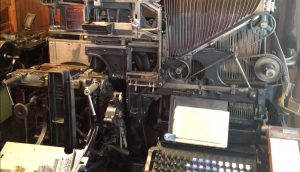
TASK 4: Manual Scripts and Potato Printing
Photo credit: Richard Payne, taken at the Burnaby Village Museum.
https://en.wikipedia.org/wiki/Linotype_machine
Part one of this week’s task is to write a diary entry, reflection, short story, or a poem to get you thinking about the process of manual writing, which so many of us now seldom do. I chose to write a letter to my daughter in the future trying to convince her to buy a house.

I type, a lot, probably averaging 4 to 5 hours every weekday. The only time I ever write by hand in the last few years is to sign my name. Although this writing task wasn’t ‘difficult’ it was frustrating to me how rusty my handwriting skills have become and it also reminded me of how different the thought process is. I did find myself very slow to actually start, but then once I committed pen to paper, I let it flow (for better or for worse). My handwritten sample was completely unedited. The times when I started to write something wrong I just ‘wrote over’ it. I used pen and paper and quite frankly, forgot just how unforgiving of a medium it is. Sacrificing neatness and accuracy I rushed to write to try to let my thoughts flow. Had I been wanting to edit this, I would have gone over it with a red pen, made notes and re-written it.
When writing with pen and paper it kind of forces you to keep the thought process going forcing you to get more immersed in it. The expression through the handwriting feels personal. In many ways, to me it also feels less professional. Although I did all my elementary and secondary schooling in handwriting, almost never using a computer, university was the opposite. And now work as well is all on the computer. The language model AI built into the software is a constant aid, fixing spelling errors, offering suggestions for more concise language, and even translating. You can always go back and edit, hyperlink references and copy and paste to your heart’s desire. While acknowledging this superior medium of putting thought to text, somehow there is still a skillset and almost an artform to handwriting that is a truly worthwhile pursuit in terms of honing your thoughts. One of my colleagues journals, I think it is a wonderful habit, I need to get over the embarrassment of my own writing and just do it.
Part two of this week’s task was to challenge making your own type setting in a fun and easy way, with potatoes!
Since my letter was about a house, I decided to make my five-letter word ‘HOUSE’.

The S ended up being blue as I wanted to signify the mistake I made in carving out the first one backwards. Other than that, it went well, it was a very enjoyable process and one that of course would improve with every try. The most challenging aspect is consistently cutting around curves. It was not time consuming, save for the fact that I involved my children, so it ended up being a larger painting adventure…
The biggest take away for me from this task, especially right after handwriting a letter was that text as language is a series of components we use as tools to build larger concepts. The closest feeling, I have ever had to this prior to this exercise perhaps would be doing calligraphy, paying attention to the detail of every letter. Taking the time to carve out each letter really felt separated from the ideas that they could later represent. It is like the worker in a factory making a widget component that will be some part of an unknown bigger mechanism. All you know is your specs, you don’t have to know how the machine will work. So too is it for us to build our toolbox of text language. First, we must learn the basic components and build up from there. Like so many skills, once we become experts, we forget the basic components as the broader skill becomes second nature. It is always a beneficial reflection to break something back down to the basics, either when trying to hone a skill or to solve a problem. It is an interesting and worthwhile practice too, to try this with the text of your written language.
